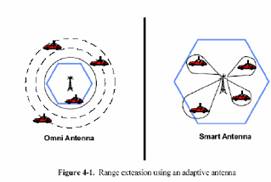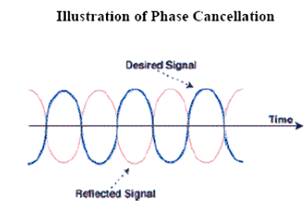





Published on Apr 02, 2024
A smart antenna consists of several antenna elements, whose signal are processed adaptively in order to exploit the spatial domain of the mobile radio channel . Usually the signals received at the different antenna elements are multiplied with complex weights W and then summed up the weights are chosen adaptively not the antenna itself, but the whole antenna system including the signal processing is called "adaptive".
The smart antenna technology can significantly improves wireless system performance and economics for a range of potential users. It enable operators of PC's cellular and wireless local loop networks to realize significant increase in signal quality, network capacity and coverage. In truth it is not the antenna that is smart but the antenna system are smart.
Terms commonly heard today that embrace various aspects of a smart antenna system technology include intelligent antennas, phased array, SDMA, spatial processing, digital beam forming, adaptive antenna systems, and others. Smart antenna systems are customarily categorized, however, as either switched beam or adaptive array systems.The following are distinctions between the two major categories of smart antennas regarding the choices in transmit strategy:
• Switched beam- a finite number of fixed, predefined patterns or combining strategies (sectors).
• Adaptive array - an infinite number of patterns (scenario-based ) that are adjusting in real time.
In a convetional time division multiple access (TDMA) or frequency division multiple access (FDMA) cellular system, carrier frequencies that are used in one cell cannot be reused in the neighboring cells, because the resulting co-channel interference would be too strong. Rather, those frequencies are reused at a greater distance. The distance (related to cell radius) between two base stations which use the same carrier frequency is named reuse distance D/R. The number of cells that have to use different carrier frequencies is called cluster size N or reuse factor. Typically, a signal-to-noise-and-interferenfe ratio (SNIR) of lODb is required for each user, resulting in a cluster size of 3 or more (N.=3) for sector cells.

Smart Antennas for TDMA (2): The increase in capacity can now be accomplished in different ways. One possibility is so-called spatial filtering for interference reduction (SFIR). Thereby, we can put base stations with the same carrier frequencies closer
It is assumed here that a smart antenna is only employed at the base station and not at the handset or subscriber unit. Such remote radio terminals transmit using omnidriectional antennas, leaving it to the base station to selectively separate the desired signals from interference selectively. Typically the received signal from the sparially distributed antenna elements is multiplied by a weight, a complex adjustment of an amplitude and a phase. These signals are combined to yield the array output. An adaptive algorithm controls the weights according to predefined objectives. For a switched beam system, this may be primarily maximum gain; for and adaptive array system, other factors may receive equal consideration. These dynamic calculations enable the system to change its radiation pattern for optimized signal reception.
When waves of two multipath signals are rotated to exactly 180° out of phses, the signals will cancel each other. While this sounds severe, it is rarely sustained on any given call (and most air interface standards are quite resilient to phase cacellation). In other words, a call can be maintained for a certain period of time while there is no signal, although with very poor quality. The effect is of more concern when the control channel signal is canceled out, resulting in a black hole, a service area in which call set-ups will occasionally fail.
Traditional switched beam and adaptive array systems enable a base station to customize the beams they generated for each remote user effectively by means of internal feedback control.

Generally speaking, each approach forms a main lobe toward individual users and attempts to reject interference or noise from outside of the main lobe.
It is assumed here that a smart antenna is only employed at the base station and not at the handset or subscriber unit. Such remote radio terminals transmit using omnidriectional antennas, leaving it to the base station to selectively separate the desired signals from interference selectively. Typically the received signal from the sparially distributed antenna elements is multiplied by a weight, a complex adjustment of an amplitude and a phase. These signals are combined to yield the array output. An adaptive algorithm controls the weights according to predefined objectives. For a switched beam system, this may be primarily maximum gain; for and adaptive array system, other factors may receive equal consideration. These dynamic calculations enable the system to change its radiation pattern for optimized signal reception.
The task of transmitting in a sparailly selective manner is the major basis for differentiating between swithched beam and adaptive array systems. The type of downlink processing used depends on whether the communication system uses time division duplex (TDD). Which transmits and receives on the same frequency (e.g., PHS and DECT) or frequency division duplex (FDD), which uses separate frequency for transmit and receiving. In most FDD systems, the uplink and downlink fading and other propagation characteristics may be considered independent, whereas in TDD systems uplink and downlink channels can be considered reciprocal. Hence, in TDD systems uplink channel information may be used to achieve spatially selective transmission. In FDD systems, the uplink channel information cannot be used directly and other types of downlink processing must be considered.
| Are you interested in this topic.Then mail to us immediately to get the full report.
email :- contactv2@gmail.com |